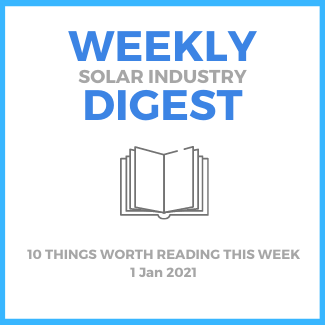Rather than drop the solar investment tax credit (ITC) to 22% in 2021, the government will leave it at 26% for two more years. This is part of a $1.4 trillion federal spending package. In 2023, ITC for the residential market will drop to 0% while the commercial and utility markets will hold at 10% in 2024.
SEPA rounded up their hottest 2020 topics: energy storage success stories like growth in Hawaii, microgrids and policy/regulators, social equity in organizations and utilities, innovation in distribution planning, and team and industry collaboration to reach a carbon-free future.
Large scale businesses seeking to go solar are looking at building an array onsite vs. connecting with a large utility-scale project offsite. The trend, though it is shifting again, is they’re opting for front of the meter installs that feed into the grid over behind the meter.
Google’s Project Sunroof is smart tech designed to solve the problem consumers have with figuring out savings from solar. It gives them info transparency via fast, accurate and clear data because its calculator tool taps data from satellite imagery to graphically map a roof’s solar potential.
CED rounds up the key solar product launches of 2020. They include solar+storage (Generac, LG, Panasonic, etc.), inverters (SMA and SolarEdge), racking (IronRidge and Unirac), modules (Q-Cells, LG, Jinko), and optimizing/MLE (SMA and Enphase).
With US utility-scale solar set to take up 2 million acres by 2030, land use needs to be addressed. Research shows that there is a need for dual-use solar: co-developing land for ecological needs and solar power tech for a symbiotic pairing that’s mutually beneficial.
Outside the box ideas from 2020: veggie based solar panels made from crop waste, a zinc-ion battery that is a cheaper, safer and longer lasting alternative to lithium-ion batteries, and the creation of a fuel emulsion that makes fossil fuels more eco friendly.
GTM highlights the highs and lows of 2020. Highs included the ITC extension, the 2020 election, and the large-scale solar boom. Lows were COVID induced chaos in residential and large-scale utility markets and the ruckus over bifacial panels and the Section 201 tariff exclusion.
Lowering the soft cost barrier to residential solar adoption and boost jobs in the industry means continued updating and streamlining of permitting (which still takes 30-40 days) and inspections (which still require in-person oversight) plus simplifying the complex standards.
Influencer Brian Lynch at LG discusses trends that shaped 2020 like the residential solar market pulling itself beyond the COVID wall it hit, the shift to digital marketing and remote sales, and a heavier emphasis on brand building to denote quality and reliability.
